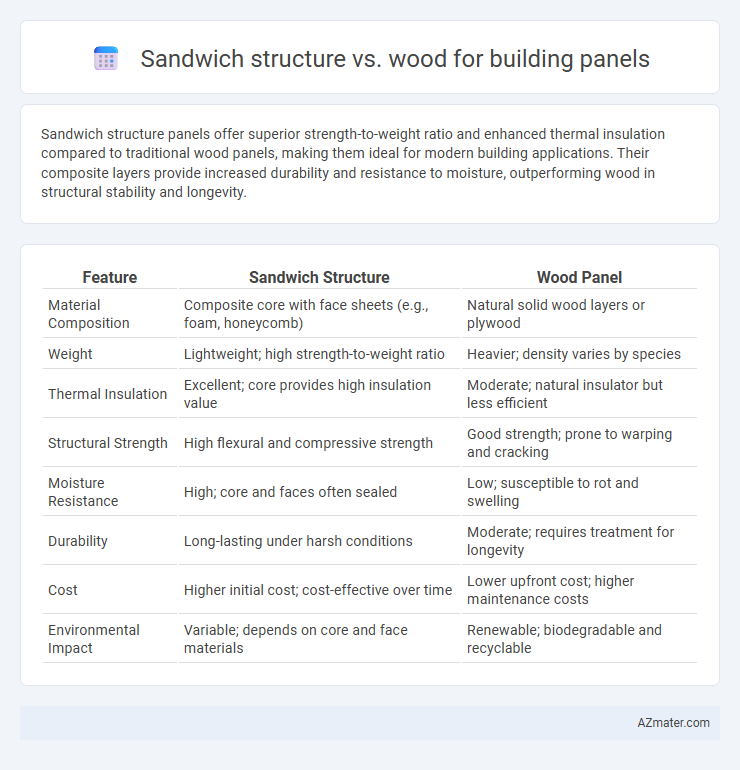Sandwich structure panels offer superior strength-to-weight ratio and enhanced thermal insulation compared to traditional wood panels, making them ideal for modern building applications. Their composite layers provide increased durability and resistance to moisture, outperforming wood in structural stability and longevity.
Table of Comparison
| Feature | Sandwich Structure | Wood Panel |
|---|---|---|
| Material Composition | Composite core with face sheets (e.g., foam, honeycomb) | Natural solid wood layers or plywood |
| Weight | Lightweight; high strength-to-weight ratio | Heavier; density varies by species |
| Thermal Insulation | Excellent; core provides high insulation value | Moderate; natural insulator but less efficient |
| Structural Strength | High flexural and compressive strength | Good strength; prone to warping and cracking |
| Moisture Resistance | High; core and faces often sealed | Low; susceptible to rot and swelling |
| Durability | Long-lasting under harsh conditions | Moderate; requires treatment for longevity |
| Cost | Higher initial cost; cost-effective over time | Lower upfront cost; higher maintenance costs |
| Environmental Impact | Variable; depends on core and face materials | Renewable; biodegradable and recyclable |
Introduction to Building Panels
Building panels utilizing sandwich structures consist of two outer layers bonded to a lightweight core, offering superior strength-to-weight ratios compared to traditional wood panels. Wood panels, commonly plywood or particleboard, provide natural insulation and aesthetic appeal but often lack the enhanced mechanical properties and durability found in sandwich panels. The sandwich panel's combination of materials delivers improved thermal performance, impact resistance, and dimensional stability crucial for modern construction demands.
Overview of Sandwich Structures
Sandwich structures consist of two strong outer layers, or face sheets, bonded to a lightweight core, providing high strength-to-weight ratios and excellent thermal insulation compared to solid wood panels. Common core materials include foams, honeycombs, or balsa wood, which enhance mechanical performance while reducing overall panel weight. These composite panels offer superior rigidity and durability, making them ideal for modern building applications where insulation and load-bearing capacity are critical.
Characteristics of Traditional Wood Panels
Traditional wood panels feature natural thermal insulation and sound absorption properties, making them favorable in building construction. Their inherent strength and durability depend on wood species, grain orientation, and moisture content, influencing load-bearing capacity and resistance to deformation. However, wood panels are susceptible to warping, swelling, and termite damage, which can affect longevity and maintenance requirements compared to engineered sandwich structures.
Structural Performance Comparison
Sandwich structures exhibit superior structural performance compared to traditional wood panels due to their higher strength-to-weight ratio and enhanced stiffness provided by the core material, typically foam or honeycomb, which distributes loads efficiently. Wood panels, while offering natural insulation and aesthetic qualities, tend to have lower flexural strength and are more susceptible to moisture-related degradation, impacting long-term durability. The sandwich panel's composite configuration delivers improved resistance to bending, shear, and impact forces, making it more suitable for high-performance building applications requiring lightweight yet robust materials.
Thermal Insulation Properties
Sandwich structures, typically composed of two strong outer layers bonded to a lightweight core, exhibit superior thermal insulation properties compared to traditional wood panels due to the core materials like foam or honeycomb that reduce heat transfer. Wood, while naturally insulating due to its cellular structure, generally offers lower insulation performance and higher thermal conductivity than advanced sandwich panel cores. The enhanced thermal resistance of sandwich panels makes them more effective for energy-efficient building envelopes, reducing heating and cooling demands significantly.
Fire Resistance Capabilities
Sandwich panels with fire-resistant cores such as mineral wool or phenolic foam exhibit superior fire resistance compared to traditional wood panels, which are inherently combustible. These sandwich structures provide enhanced thermal insulation and char formation that slows fire spread, meeting stringent building codes like ASTM E84 and EN 13501. Wood panels often require additional treatments and coatings to achieve comparable fire resistance, increasing overall construction complexity and cost.
Durability and Lifespan
Sandwich structures typically offer superior durability and extended lifespan compared to traditional wood panels due to their engineered core materials like foam, honeycomb, or metal, which provide enhanced resistance to moisture, decay, and mechanical stress. Wood panels are susceptible to warping, rot, and insect damage, which significantly reduces their longevity without regular maintenance and protective treatments. Advanced sandwich panels commonly used in construction combine high-strength outer layers with lightweight cores, resulting in panels that withstand harsh environmental conditions and maintain structural integrity over decades.
Environmental Impact Analysis
Sandwich panels typically combine lightweight cores such as foam or honeycomb with durable facings, resulting in lower material consumption and reduced carbon footprint compared to traditional solid wood panels. Wood panels, while renewable and biodegradable, often involve more significant deforestation risks and longer recovery periods for raw materials, impacting sustainability metrics negatively. Life cycle assessments consistently show sandwich structures can offer superior thermal insulation and energy efficiency, reducing overall environmental impact during the building's operational phase.
Cost and Installation Considerations
Sandwich structure panels offer superior cost-efficiency due to their lightweight nature, reducing transportation and labor expenses compared to traditional wood panels. Installation of sandwich panels is faster and requires fewer specialized tools, which lowers overall project timelines and labor costs. Wood panels, while potentially cheaper per unit, often incur higher installation costs due to weight and handling complexity, impacting total construction budgets.
Future Trends in Building Panel Materials
Sandwich structures incorporating advanced composites and recyclable cores are gaining prominence over traditional wood panels due to their superior strength-to-weight ratios, enhanced thermal insulation, and sustainability benefits. Innovations in bio-based resins and nanomaterial reinforcements are driving the development of eco-friendly, durable sandwich panels that meet increasing environmental regulations. Future trends indicate a shift towards hybrid panels combining wood fibers with engineered cores to optimize performance, reduce carbon footprint, and enable smart building applications.

Infographic: Sandwich structure vs Wood for Building panel
 azmater.com
azmater.com